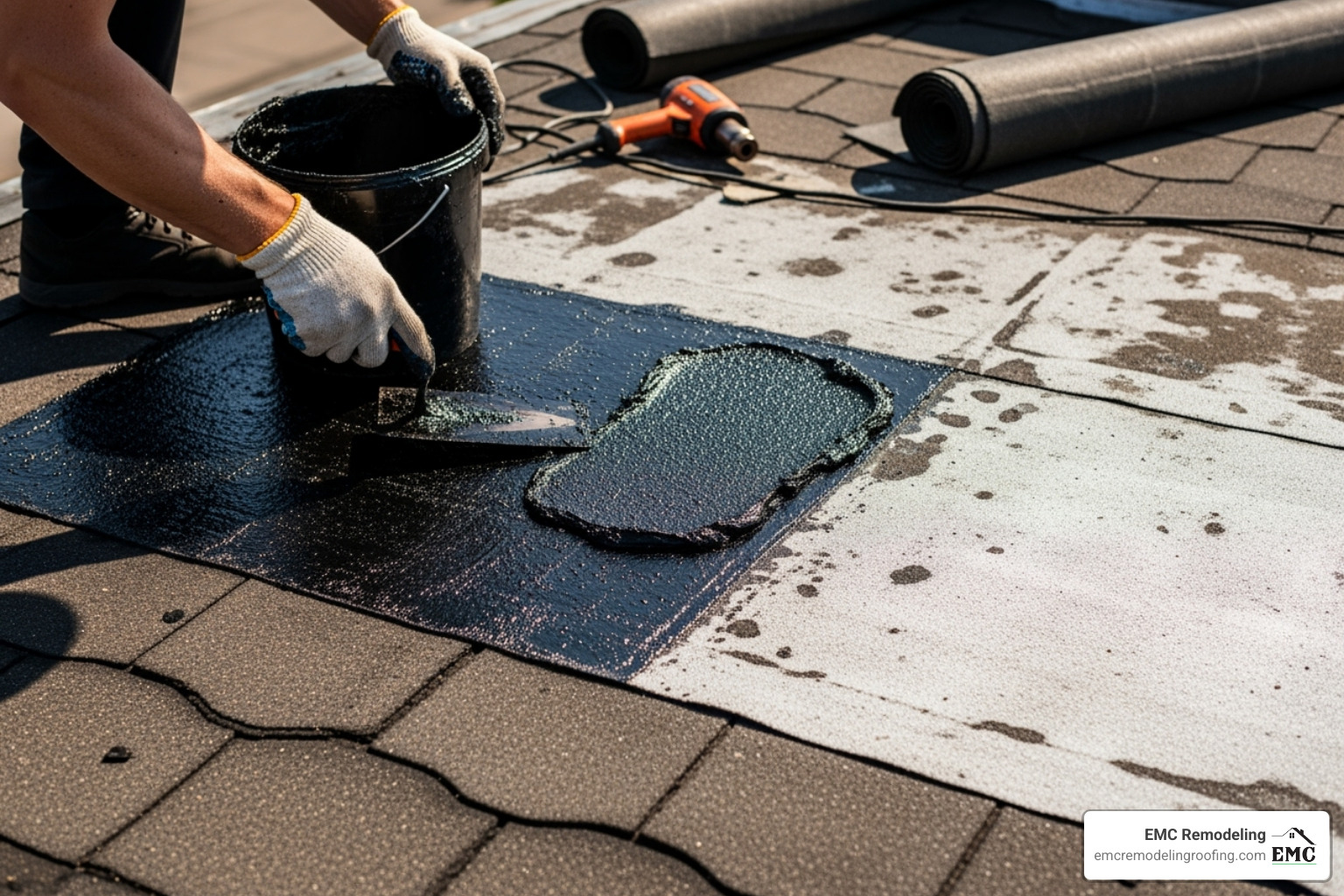Why Liquid Solutions Are Revolutionizing Asphalt Flat Roof Repair
Asphalt flat roof repair doesn’t have to mean expensive bills or long waits. Modern liquid-applied solutions empower homeowners to tackle common roofing problems like minor leaks and weathering damage.
Quick Answer for Asphalt Flat Roof Repair:
- Minor cracks: Apply roofing cement with a trowel, feathering edges smooth.
- Blisters: Cut an “X”, dry the area, and apply cement under the flaps.
- Holes under 1 inch: Clean, fill with roofing cement, and embed fiberglass mesh.
- Larger tears: Use a base coat, fiberglass mesh, and top coat system.
- Flashing issues: Remove old sealant and apply fresh flashing cement.
- When to call pros: Damage over 10% of the roof, persistent leaks, or structural sagging.
Flat roofs face unique challenges like ponding water, relentless UV exposure, and stress from thermal expansion. Fortunately, most asphalt flat roof problems respond well to liquid repair solutions when caught early.
For any roofing needs, from minor fixes to major overhauls, EMC Remodeling provides expert services throughout Central Texas.
I’m Matthew Runyon, President of EMC Remodeling & Roofing. With over 15 years of hands-on experience in Central Texas, I’ve seen how the right liquid solutions for asphalt flat roof repair can extend your roof’s life by years when applied correctly.
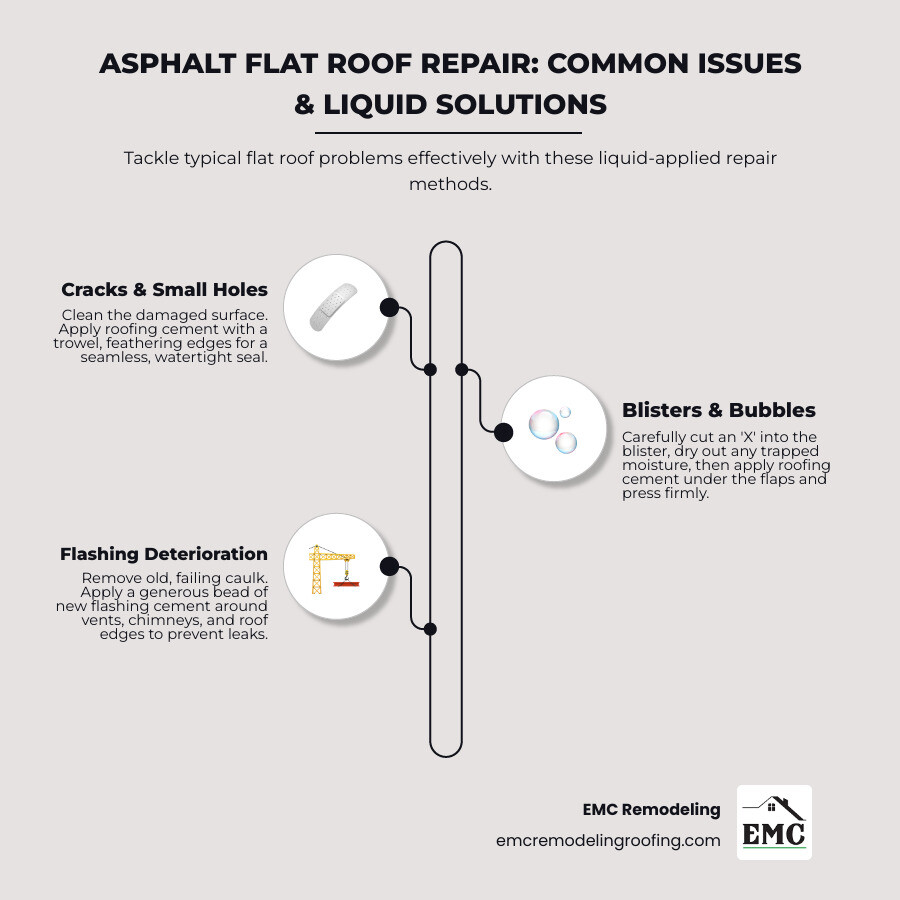
Asphalt flat roof repair terms to learn:
Decoding the Damage: 5 Telltale Signs Your Asphalt Roof Is Crying for Help
Your flat roof shows signs of wear before it fails. Catching these warning signals early can prevent expensive emergencies. From my experience with asphalt flat roof repair across Central Texas, roofs rarely fail overnight; they provide hints, and sometimes the first signs appear inside your home.
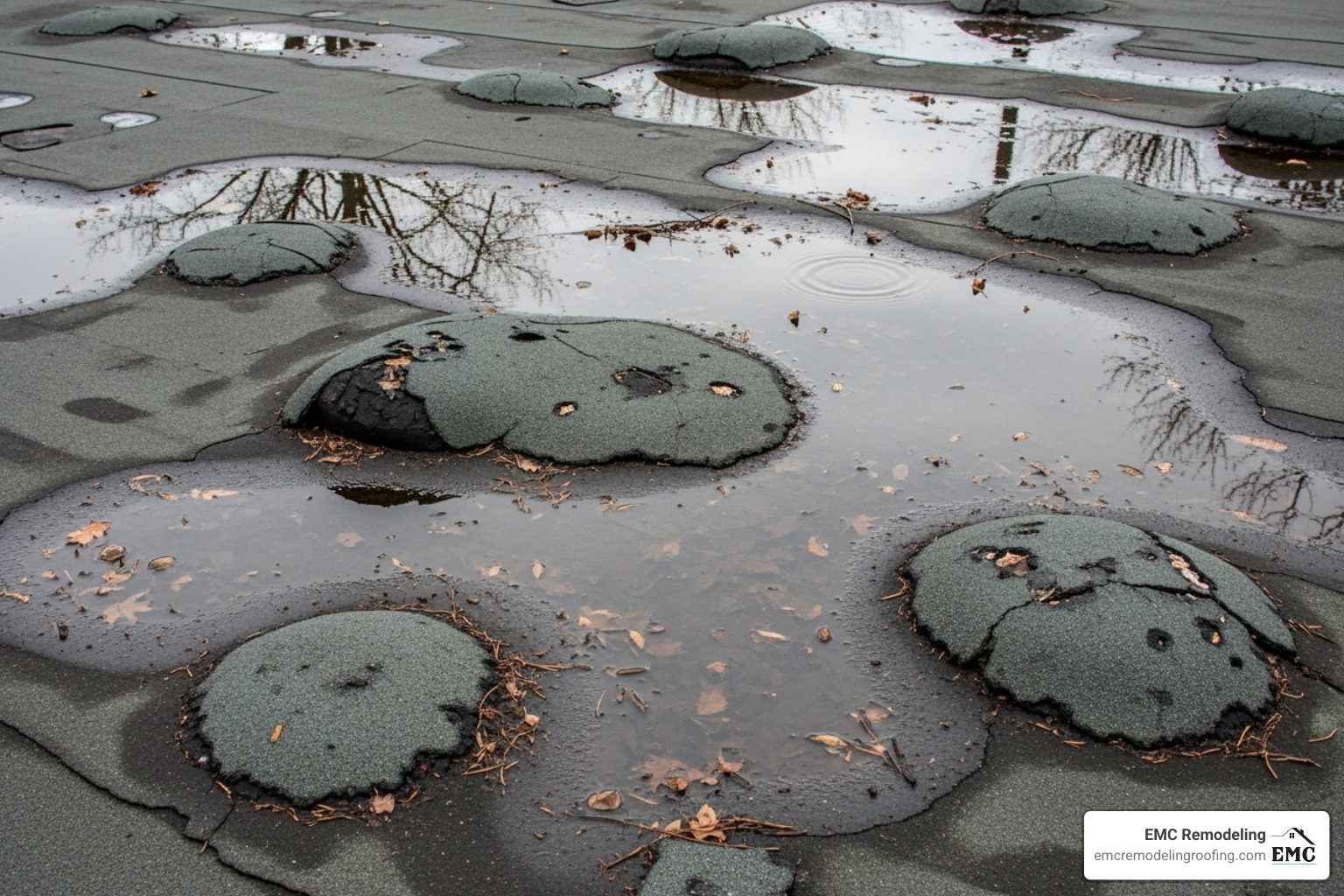
Interior Signs: Your Home’s Early Warning System
Ceiling stains: Brown or yellow patches on your ceiling after rain are direct signs of a leak. The source of the leak on the roof may be far from where the stain appears.
Mold growth: Fuzzy patches on walls or a musty smell indicate a long-term leak that has created a moisture problem, posing a health risk to your family.
Exterior Signs: Reading Your Roof’s Body Language
When safely on a dry roof, your asphalt surface will reveal its condition.
Ponding water: Water sitting on your roof for more than 48 hours after rain indicates poor drainage. This standing water actively breaks down your roof membrane.
Cracks and alligatoring: Small cracks are entry points for water. Alligatoring—a pattern resembling reptile skin—means the asphalt has lost its flexibility and is prone to splitting.
Blisters and bubbles: These pockets of trapped air or moisture expand in the sun and can burst, creating a direct path for water.
Bald spots and missing gravel: The gravel layer protects the underlying asphalt from UV damage. Missing gravel exposes the membrane, causing it to become brittle and age rapidly.
Flashing issues: Damaged flashing around vents, chimneys, and skylights is a leading cause of leaks. When it cracks or pulls away, water gets in easily.
A professional Roof Inspection can identify hidden damage before it worsens. What appears to be a small issue on the surface can often indicate a much larger problem underneath.
The DIYer’s Arsenal: Essential Tools & Safety Protocols for Flat Roof Work
Before starting any asphalt flat roof repair, safety is paramount. A fall from any height can be life-altering, so never underestimate the risks of working on a flat roof.
Safety First, Always!
Your safety gear is not optional; it’s your lifeline.
- Non-slip boots provide essential traction.
- A safety harness, secured to an anchor point, is critical when working near edges.
- Gloves protect your hands from sharp edges and chemicals.
- Safety goggles shield your eyes from debris and reflected UV rays.
Ladder safety is crucial, as most accidents happen when getting on or off the roof. Use a properly rated ladder, have a spotter, and avoid carrying too much at once. Finally, a non-negotiable rule: work only in dry weather. Wet surfaces are slippery, and repair materials won’t adhere correctly.
Equipping Your Repair Mission
The right tools and quality materials are essential for a successful asphalt flat roof repair, saving you time and money.
Repair Materials:
- Asphalt roofing cement: Your workhorse for most small repairs.
- Liquid-applied membrane sealant: Ideal for creating a seamless, waterproof layer over larger areas.
- Bitumen primer: Prepares weathered surfaces to ensure new materials adhere properly.
- Fiberglass mesh fabric: Adds structural strength to patches.
Essential Tools:
- Utility knife: For cutting damaged membrane and patch materials.
- Trowel: To spread roofing cement smoothly.
- Caulking gun: For precise application of sealants.
- Stiff-bristled brush: To clear away debris before application.
- Heavy-duty roller: To press patches firmly, eliminate air bubbles, and ensure a strong bond.
With your safety gear on and tools organized, you’re ready to tackle flat roof problems.
Your Step-by-Step Guide to Asphalt Flat Roof Repair
Tackling asphalt flat roof repair yourself can extend your roof’s life and prevent severe water damage. The key to success is patience and thoroughness; rushing a repair often leads to failure.
Step 1: Pinpointing the Leak’s Elusive Source
Finding a leak’s source is tricky, as water can travel horizontally under the roof membrane. Start with a full damage assessment, looking for cracks, blisters, and damaged flashing. Then, thoroughly clean the area.
- Debris Removal: Use a stiff broom or leaf blower to clear away all loose gravel, leaves, and branches. Debris prevents repair materials from bonding correctly.
- Surface Cleaning: Use a stiff-bristled brush and a solvent like mineral spirits to remove grime from the damaged area. The surface must be completely dry before you proceed.
- Leak Tracing: If you see a leak inside, measure its location and find the corresponding spot on the roof. Always inspect up-slope from the interior stain, as water flows downhill. For persistent leaks, use a water hose on suspected areas while a partner watches for drips inside.
Step 2: Sealing Minor Cracks and Holes Like a Pro
Minor cracks (under 1-inch wide) and small punctures are easily fixed with roofing cement. This method can add years to your roof’s life.
- Prepare the Surface: Ensure the area is completely clean and dry.
- Apply Cement: Use a trowel to apply roofing cement generously over the crack, extending 2-3 inches beyond the damage.
- Feather the Edges: Smooth the cement outward to create a seamless transition with the existing roof surface, preventing water from pooling.
- Reinforce if Needed: For added durability, embed a small piece of fiberglass mesh into the wet cement and cover it with another thin layer.
Step 3: Conquering Blisters and Patching Larger Tears
Blisters and larger tears require a more robust, multi-layer repair method.
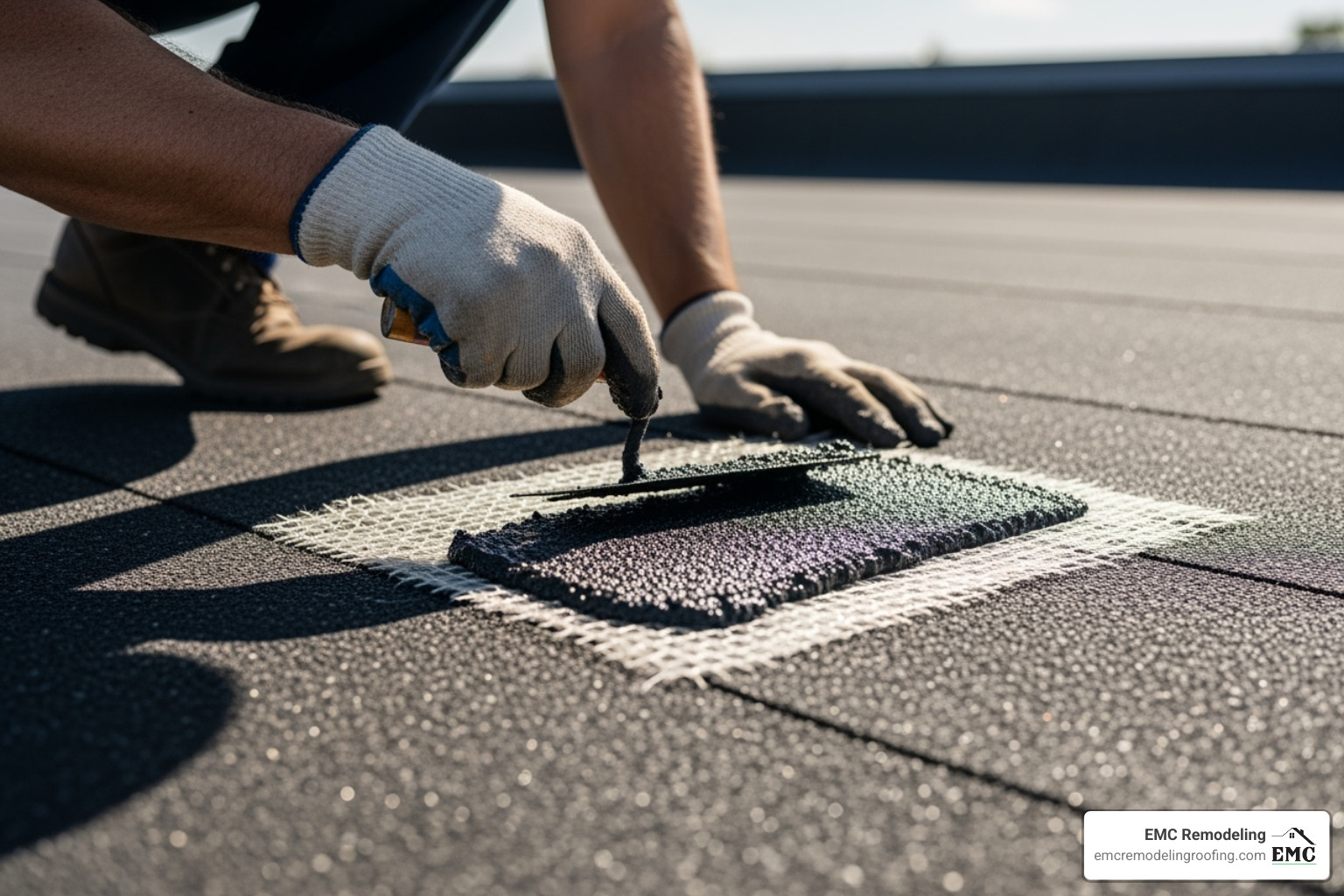
To Repair a Blister:
- Cut an ‘X’ pattern through the blister’s center with a utility knife.
- Lift the flaps and use rags to absorb all trapped moisture.
- Allow the area to dry completely, using a heat gun on a low setting with caution.
- Apply roofing cement under each flap and press them down firmly.
- Cover the entire repair with another layer of cement and embed fiberglass mesh for strength.
To Patch a Large Hole:
- Apply a base coat of cement extending 6 inches beyond the hole.
- Embed fiberglass mesh into the wet cement, ensuring it lies flat.
- Apply a top coat of cement, completely covering the mesh and feathering the edges.
- For tar and gravel roofs, spread new gravel into the wet top coat for UV protection.
For historic buildings, specific guidelines may apply, as noted in the GSA’s guide on Minor Repairs To Asphalt Roll-Roofing.
Step 4: Fortifying Flashings and Edges Against Water Intrusion
Flashing failures around vents, chimneys, skylights, and roof edges are a primary cause of asphalt flat roof repair needs.
- Remove Old Sealant: Carefully scrape away old, cracked sealant.
- Clean the Area: Use a stiff brush and solvent to ensure a clean surface for adhesion.
- Apply Flashing Cement: Apply a generous bead of flashing cement along all seams and smooth it with a trowel.
- Ensure Proper Height: Flashing should extend 8-14 inches up vertical surfaces for optimal protection, a standard recommended by the National Roofing Contractors Association (NRCA).
A Roof Leaking Around Chimney is a common issue that requires careful attention to both base and counter-flashing.
Repair or Replace? Making the Right Call for Your Roof
Deciding between repair and replacement is a major question for homeowners. While repairs can extend a roof’s life, sometimes replacement is the only viable option. Key factors can help you make the right choice.
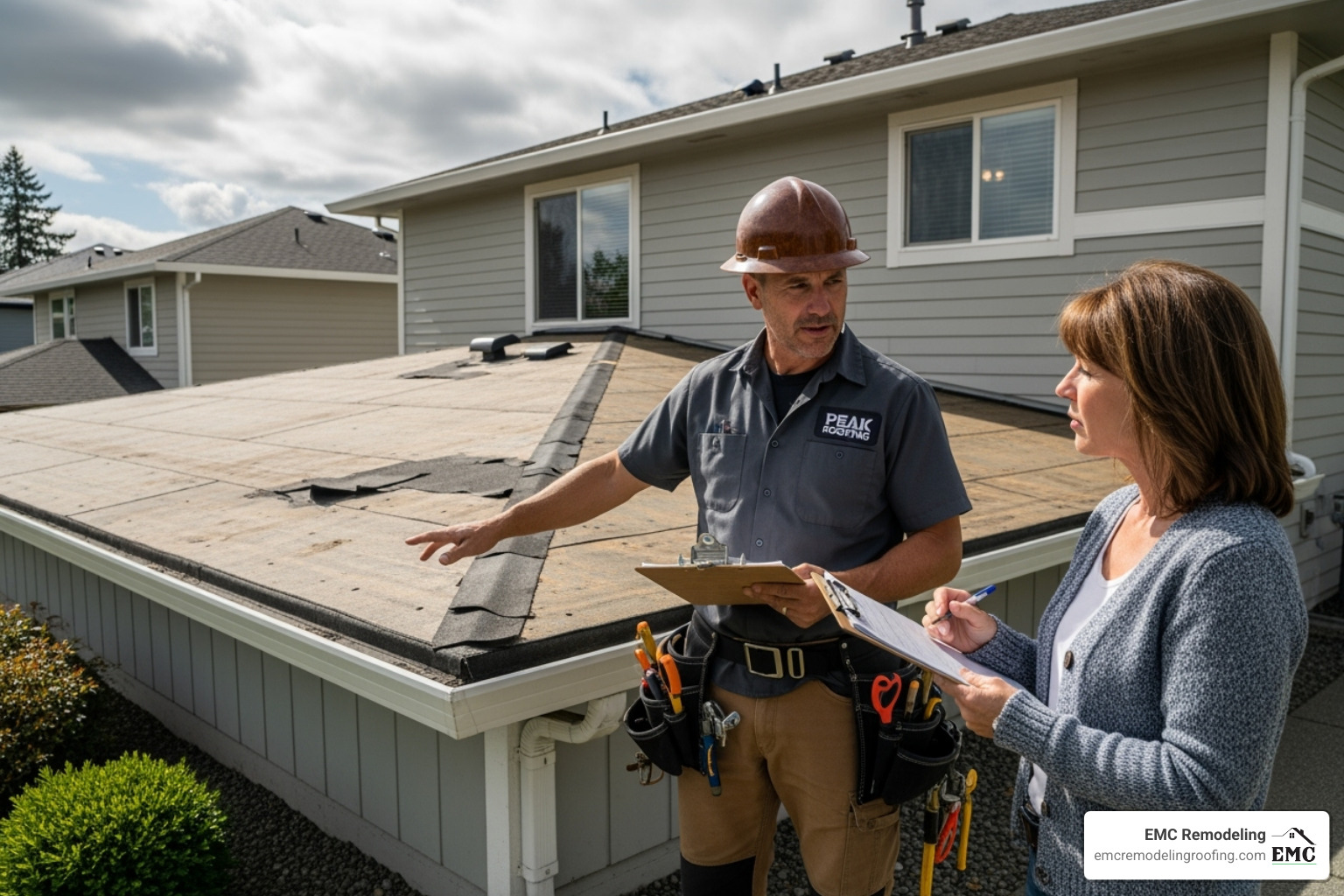
- Roof Age: A properly maintained tar and gravel roof can last 20-25 years. If your roof is over 15 years old and has multiple issues, repair costs can accumulate, making replacement a better long-term investment.
- Extent of Damage: Isolated issues are good candidates for asphalt flat roof repair. However, if more than 10% of your roof is damaged—with widespread alligatoring, multiple leaks, or sagging—it’s time to consider replacement.
- Cost-Benefit Analysis: A single repair is cheaper than a replacement, but frequent fixes add up. Widespread damage often signals the need for a full Roof Repair and Replacement.
The Lifespan of Your Roof: Key Maintenance Practices
Consistent maintenance is the secret to maximizing your flat roof’s lifespan. Neglecting it will lead to costly problems.
- Bi-annual inspections (spring and fall) help you catch problems early.
- Clearing debris like leaves and branches prevents moisture buildup and clogged drains.
- Cleaning gutters and drains is essential to prevent ponding water, a primary cause of roof deterioration.
- Checking for vegetation growth like moss or algae helps protect the membrane from degradation.
Addressing small issues promptly prevents them from becoming major emergencies.
When to Call a Professional for Asphalt Flat Roof Repair
While DIY is great, some situations demand professional expertise.
- Safety concerns: High roofs, discomfort with heights, or bad weather.
- Large damaged areas: Damage over 10% of the roof suggests systemic failure.
- Persistent leaks: If DIY repairs fail, the problem is likely deeper than the surface.
- Structural sagging: This indicates a serious issue requiring immediate expert assessment.
When you need an Estimate for Roof Repair, we provide transparent quotes. For sudden, major leaks, you may need Emergency Roofing Near Me, as we offer 24/7 services.
Frequently Asked Questions about Asphalt Flat Roof Repair
Here are answers to the most common questions we receive about asphalt flat roof repair.
What are the common types of asphalt flat roofing?
There are two primary types of asphalt flat roofing systems:
- Built-Up Roofing (BUR): Often called “tar and gravel,” this system consists of multiple layers of asphalt and reinforcing fabric, topped with a protective gravel layer. A well-maintained BUR roof can last 20-30 years and is naturally fire-resistant.
- Modified Bitumen (Mod-Bit): This is a single-ply rolled roofing membrane where the asphalt is modified with polymers for rubber-like flexibility. It excels at handling temperature fluctuations, which prevents cracking. It can be torch-applied, self-adhered, or cold-applied.
How can I resolve ponding water issues?
Ponding water is a major threat to flat roofs. Water that remains for over 48 hours after rain will inevitably cause damage. First, clear all drains and scuppers of debris. If water still pools, the roof may have structural low spots. This requires a professional solution, such as building up the low area or installing tapered insulation to create a proper slope that directs water to the drains.
What are the typical costs for repairs?
Asphalt flat roof repair costs vary based on the extent of the damage.
- Minor DIY repairs for small cracks or holes typically cost $50 to $200 in materials.
- Professional repairs generally range from $5 to $10 per square foot. Most contractors have a minimum service charge, often starting between $400 and $750, to cover labor and overhead for smaller jobs.
For extensive damage, costs can be in the thousands, so it’s wise to get multiple quotes.
Your Next Steps for a Secure, Leak-Free Roof
You now have a solid understanding of asphalt flat roof repair, from identifying warning signs to performing the fixes. This knowledge can save you significant money on future emergency repairs.
Proactive repairs are your roof’s best defense. Fixing small cracks and blisters today is far cheaper than dealing with major leaks during a Texas thunderstorm. While you are equipped for small DIY jobs, know when to call for professional expertise, especially when safety and longevity are at stake.
Regular maintenance is key to extending your roof’s lifespan. Bi-annual inspections serve as an early warning system against costly surprises.
As a family-operated business in Temple, TX, EMC Remodeling understands the urgency of protecting your home from Central Texas weather. We serve homeowners in Temple, Killeen, Leander, Cedar Park, Georgetown, Belton, Pflugerville, and Salado, providing service we’d want for our own families.
If you’re facing a roofing emergency or need an expert assessment of your flat roof’s condition, don’t gamble with your home’s protection. For reliable 24/7 service and a free estimate, contact our experienced roofing company today. We’re here around the clock because roof emergencies don’t wait for business hours.
